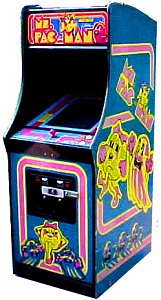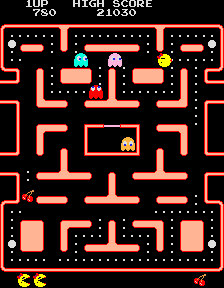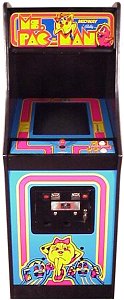 The Game: As the bride of that most famous of single-celled omniphage life forms, your job is pretty simple – eat all the dots, gulp the large blinking dots in each corner of the screen and eat the monsters while they’re blue, and avoid the monsters the rest of the time. Occasionally various fruits and other foods will bounce through the maze, and you can gobble those for extra points. Every so often, just to give you
The Game: As the bride of that most famous of single-celled omniphage life forms, your job is pretty simple – eat all the dots, gulp the large blinking dots in each corner of the screen and eat the monsters while they’re blue, and avoid the monsters the rest of the time. Occasionally various fruits and other foods will bounce through the maze, and you can gobble those for extra points. Every so often, just to give you  a chance to relax, you’ll see a brief intermission chronicling the courtship of Mr. and Mrs. Pac-Man (and a little hint at who the next game would star). (Bally/Midway [under license from Namco], 1982)
a chance to relax, you’ll see a brief intermission chronicling the courtship of Mr. and Mrs. Pac-Man (and a little hint at who the next game would star). (Bally/Midway [under license from Namco], 1982)
Memories: The first real sequel (excluding any altered pirate clones or enhancement kits for the original Pac-Man) in the Pac-Universe, Ms. Pac-Man added quite a few new twists to the original game without changing how it’s played. The new mazes, extra side tunnels (on some mazes), and bouncing fruit were about the only things that could be changed without drastically altering the game (though the later Jr. Pac-Man addition of a scrolling maze was interesting).
But Ms. Pac-Man, though it’s heartily embraced and marketed by Namco now, didn’t originate with Namco or even with Midway. Ms. Pac-Man started life as a completely unauthorized “enhancement kit” in the form of a daughterboard that could be attached to the motherboard of a legitimate Pac-Man coin-op. It was created by  the later founders of General Computer, who would later wind up with a lucrative contract to create arcade and console games for Atari. Originally, their kit didn’t add a gender to the Pac-race at all: it would’ve added legs to Pac-Man and retitled the game Crazy Otto. The project was handed over to Midway in a deal that was somewhere between making a sale and settling to avoid an oncoming lawsuit, and apparently Namco – the Japanese originators of Pac-Man – weren’t that impressed with the new game, as they were already working on their own sequel, Super Pac-Man. Despite these unlikely origins, Ms. Pac-Man went on to become the most successful arcade game of all time. Considering the number of Namco-published retro compilations it’s appeared on, Ms. Pac-Man seems to have survived meeting Pac-Man’s family.
the later founders of General Computer, who would later wind up with a lucrative contract to create arcade and console games for Atari. Originally, their kit didn’t add a gender to the Pac-race at all: it would’ve added legs to Pac-Man and retitled the game Crazy Otto. The project was handed over to Midway in a deal that was somewhere between making a sale and settling to avoid an oncoming lawsuit, and apparently Namco – the Japanese originators of Pac-Man – weren’t that impressed with the new game, as they were already working on their own sequel, Super Pac-Man. Despite these unlikely origins, Ms. Pac-Man went on to become the most successful arcade game of all time. Considering the number of Namco-published retro compilations it’s appeared on, Ms. Pac-Man seems to have survived meeting Pac-Man’s family.
 The character of Ms. Pac-Man, such as it was, suddenly lent all sort of motivations and personality to the original. A Bally pinball game, Mr. & Mrs. Pac-Man, left no doubt as to what that relationship was, and a disastrous video-pinball hybrid called Baby Pac-Man (also by Bally) and Jr. Pac-Man left no doubt as to the results.
The character of Ms. Pac-Man, such as it was, suddenly lent all sort of motivations and personality to the original. A Bally pinball game, Mr. & Mrs. Pac-Man, left no doubt as to what that relationship was, and a disastrous video-pinball hybrid called Baby Pac-Man (also by Bally) and Jr. Pac-Man left no doubt as to the results.
Atari redeemed themselves admirably with an extremely faithful Atari 2600 rendition of Ms. Pac-Man, featuring almost every nuance of its arcade inspiration (due in no small part to being outsourced to Atari’s new contractor, General Computer). Coleco also released a  Ms. Pac-Man battery-powered tabletop arcade game, and featured Ms. Pac in its line of Pac-toys. She also played a prominent part in ABC’s short-lived Pac-Man Saturday morning cartoon and several children’s records released by KidStuff records. Numerous dolls, stickers, wristwatches, and other merchandise were also graced by Ms. Pac’s likeness.
Ms. Pac-Man battery-powered tabletop arcade game, and featured Ms. Pac in its line of Pac-toys. She also played a prominent part in ABC’s short-lived Pac-Man Saturday morning cartoon and several children’s records released by KidStuff records. Numerous dolls, stickers, wristwatches, and other merchandise were also graced by Ms. Pac’s likeness.
